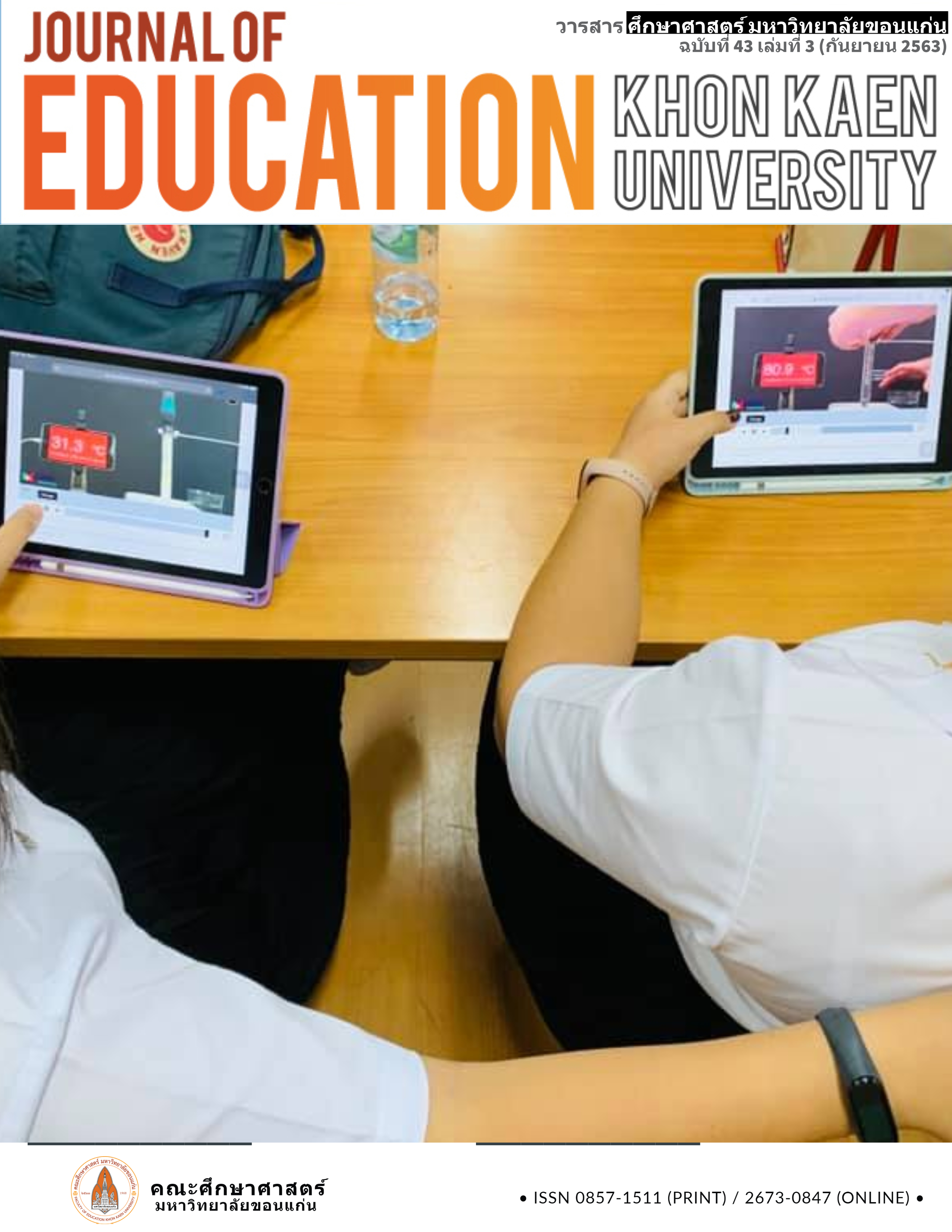DEVELOPING PROBLEM SOLVING ABILITIES AND MATHEMATICAL CREATIVITY ON PROBABILITY OF EVENTS BY USING CREATIVE PROBLEM SOLVING OF MATHAYOM SUKSA III STUDENTS
Main Article Content
Abstract
The purposes of this research were to: 1) to study the development of mathematical problem solving ability of mathayom suksa III students who received learning management using creative problem solving 2) to study the development of mathematical creativity of mathayom suksa III students who received learning by using creative problem solving and 3) to study the satisfaction of mathayom suksa III students towards learning management by using creative problem solving. The sample group was 36 mathayom suksa III students in class number 4 in the second semester of academic year 2019 from Kanchanapisekwittayalai Suphanburi School and was acquired by Cluster random sampling. The tools used in this research were 1) lesson plans with creative problem solving 2) Subjective test and 3) Satisfaction assessment form of learning management. The data were analyzed by Repeated measures ANOVA, calculating for mean and standard deviation. The results of the study were as follows: 1) Problem solving ability, the post-learning was higher than the pre-learning significantly at the 0.01 level; problem solving ability of mathayom suksa III students, the scores between-learning and post-learning were higher than the pre-learning significantly at the 0.05 level
2) Mathematical creativity, the post-learning was higher than the pre-learning significantly at the 0.01 level; mathematical creativity of mathayom suksa III students, the scores between-learning and post-learning were higher than the pre-learning significantly at the 0.05 level and 3) For mathayom suksa III students learning by creative problem solving have the satisfaction at the high level with the average score () = 3.90 and standard deviation (S.D.) was 0.58.
Article Details
References
กระทรวงศึกษาธิการ. (2560). หลักสูตรแกนกลางการศึกษาขั้นพื้นฐาน พุทธศักราช 2551 (ฉบับปรังปรุง 2560). กรุงเทพฯ: โรงพิมพ์ชุมนุมสหกรณ์การเกษตรแห่งประเทศไทย.
โครงการ PISA ประเทศไทย สถาบันส่งเสริมการสอนวิทยาศาสตร์และเทคโนโลยี. (2561). ผลการประเมิน PISA 2015 วิทยาศาสตร์ การอ่าน และคณิตศาสตร์ ความเป็นเลิศและความเท่าเทียมทางการศึกษา. กรุงเทพฯ: ซัคเซสพับลิเคชั่น.
ดวงสมร เหลาราช. (2554). การพัฒนาความสามารถในการแก้ปัญหา ผลสัมฤทธิ์ทางการเรียนคณิตศาสตร์ และความพึงพอใจต่อการเรียน โดยใช้คู่มือการจัดการเรียนรู้แบบร่วมมือรูปแบบ STAD ร่วมกับ การแก้ปัญหาเชิงสร้างสรรค์ ของนักเรียนชั้นประถมศึกษาปีที่ 1 ศูนย์เครือข่ายสถานศึกษาตำบลหนองสนม. วิทยานิพนธ์ปริญญามหาบัณฑิต การวิจัยและพัฒนาการศึกษา มหาวิทยาลัยราชภัฏสกลนคร.
ธัญญารัตน์ โกมลเกียรติ. (2557). ผลของการจัดกิจกรรมการเรียนรู้คณิตศาสตร์โดยใช้กระบวนการแก้ปัญหาเชิงสร้างสรรค์ที่มีต่อความสามารถในการแก้ปัญหาและความคิดสร้างสรรค์ทางคณิตศาสตร์ เรื่อง การประยุกต์ 1 สำหรับนักเรียนชั้นมัธยมศึกษาปีที่ 1. วิทยานิพนธ์วิทยาศาสตรมหาบัณฑิต สาขาวิชาคณิตศาสตร์ศึกษา มหาวิทยาลัยบูรพา.
สถาบันทดสอบทางการศึกษาแห่งชาติ (องค์การมหาชน). (2561). สรุปผลการทดสอบทางการศึกษาระดับชาติขั้นพื้นฐาน (O-NET) ชั้นมัธยมศึกษาปีที่ 3 ปีการศึกษา 2561. ค้นเมื่อ 9 กันยายน 2562, จาก https://www.newonetresult.niets.or.th/AnnouncementWeb/Login.aspx
สมปอง เพชรโรจน์. (2549). การนำเสนอรูปแบบการเรียนการสอนบนเว็บโดยใช้การจัดการเรียนรู้แบบสืบสอบเพื่อการแก้ปัญหาเชิงสร้างสรรค์ สำหรับนิสิตปริญญาบัณฑิต สาขาวิชาวิทยาศาสตร์กายภาพและเทคโนโลยี จุฬาลงกรณ์มหาวิทยาลัย. วิทยานิพนธ์ปริญญามหาบัณฑิต สาขาโสตทัศนศึกษา จุฬาลงกรณ์มหาวิทยาลัย.
อรวรรณ ตัณสุวรรณรัตน์. (2552). ผลของการจัดกิจกรรมการเรียนรู้คณิตศาสตร์ โดยใช้กระบวนการแก้ปัญหาเชิงสร้างสรรค์ ที่มีต่อความสามารถในการแก้ปัญหา และความคิดสร้างสรรค์ทางคณิตศาสตร์ ของนักเรียนมัธยมศึกษาปีที่ 2. วิทยานิพนธ์ครุศาสตร์มหาบัณฑิต สาขาวิชาการจัดการศึกษาคณิตศาสตร์ จุฬาลงกรณ์มหาวิทยาลัย.
Alexander, D. (2007). Effects of Instruction in Creative Problem Solving on Cognition, Creativity, and Satisfaction among ninth grade students in an introduction to world agricultural science and technology course. Texas Tech University.
Bertalanffy, L. V. (1950). An Outline of General System Theory. The British Journal for the Philosophy of Science, 1 (2), 134 – 165.
Parnes, S.J. (1967). Creative Behavior Guidebook. New York: Charles Scribner, Son.
Treffinger, D. J., Isaksen, S.G., and Doval, K. B. (2000). Creative problem solving (CPS) A contemporary framework for managing change. Retrieved September 10, 2019, from https://www.creativelearning.com/index.htm
Zulyadain. (2017). Effects of Creative Problem Solving Learning Model on Mathematical Problem Solving Skills of Senior High School Students. IOSR Journal of Research & Method in Education (IOSR-JRME), 7(3), 33 - 37.

